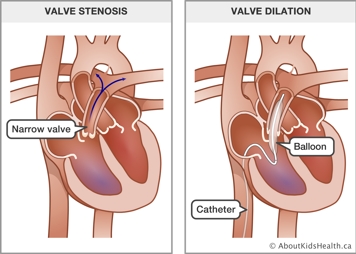A balloon valvuloplasty uses an inflated balloon to open up a heart valve. This page explains what the procedure entails and how it will help your child's heart condition.
What is a balloon valvuloplasty?
A balloon valvuloplasty is a procedure done to open a heart valve that is abnormally obstructed or narrow (stenotic). It is also called a valve dilation or a balloon valvotomy.
Heart valves are like gates that control the flow of blood between the upper and lower chambers of the heart, as well as the flow out of the heart.
How is a balloon valvuloplasty done?
The procedure is performed while your child is under a general anaesthetic. This means that your child will be asleep during the procedure.
During the catheterization, the doctor threads a special catheter through your child’s blood vessels to the valve. The team takes X-ray pictures and measurements of the valve. Then the team threads a deflated balloon on the tip of the catheter to the narrowed valve. The balloon is then inflated to open up the narrowed valve. Sometimes a second larger balloon is used to dilate the area further.
Then the balloon is deflated. The doctor takes out the balloon and catheter, and covers the cuts on your child’s leg with a bandage.

What are the potential complications?
Pulmonary valve dilations
Sometimes the pulmonary valve becomes leaky after a balloon valvuloplasty. This condition, called valve incompetence, is usually mild and can occur after surgical valvuloplasty as well.
Most pulmonary valves (80%) are narrowed because parts of the valve are stuck together, but they respond well to dilation. Some valves, however, do not improve enough with the procedure and may need surgery. For example, a so-called dysplastic valve, with leaflets that may not be so stuck together, does not always improve with dilation, although the procedure is often tried before surgery is considered.
Aortic valve dilations
The aortic valve controls the flow of blood from the heart to the aorta, which carries blood to the body. When this valve is too narrow, the pressure in the heart is too high and the heart has to work too hard to pump blood. However, if the valve is expanded to get rid of all the narrowing, it will probably leak. The goal of aortic valve dilation is to make the narrowing just wide enough to reduce the pressure in the heart to safe levels, without causing a significant leak.
The doctor chooses a balloon that is small enough that it will not get rid of all the narrowing. Then surgery can be avoided. In 2% to 3% of cases, the valve becomes very leaky, even when the right-sized balloon is used. If this happens, your child may need surgery to repair the valve.